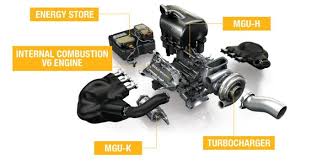Formula one power units are the most complicated parts in the cars. In 2014 there was a major switch from a 2.4L normally aspirated V8 engine to the current 1.6L direct injection turbo charged V6 engines. There are 6 components in these power houses, and they all do a specific job to help the car run the smoothest it can.
Internal Combustion Engine (ICE)
This is basically just a super fancy gas engine. Like in any other road car the engine is hooked up to the crank shaft. The engine turns the crank shaft which in turn turns the wheel at a max of 15 000 rpm. This engine is a V6, which means it has 6 pistons arranged in a V formation in the engine block. Each piston is inside an individual combustion chamber, which powers the car. Typically an engine, air and fuel are mixed and sucked into the combustion chamber of each piston, which means a lot of wasted fuel. Current F1 cars inject fuel directly into the combustion chambers, separate from the air that is sucked in, so it is much more fuel efficient. This allows the team to inject exact quantities of fuel and air so they have more control over the power.
Turbo Charger (TC)
This is an energy recovery device that uses waste exhaust energy to drive a single stage exhaust turbine. That turbine then drives a single stage compressor via a shaft, thereby increasing the pressure of the inlet charge. The Inlet Charge is the air admitted into the engine for combustion. It is a key system for increasing the efficiency of the ICE. When the driver breaks the TC slows down, causing less air to be let into the engine, so it needs some help from the MGU-H to boost its power.
MGU-H
The MGU-H is the Motor Generating Unit – Heat. It has two jobs which is to suck excess energy out of the engine, and to drive extra energy into the turbo charger when it slows down. It is used to quickly boost the TC back up to speed when a driver accelerates again so the engine doesn’t have to wait for the TC to catch up again. This called eliminating ‘Turbo lag’.
MGU-K
The MGU-K is the Motor Generating Unit – Kinetic. It is a generator that works in two ways: it can capture energy under breaking and it can feed said energy into the engine to generate an extra 160 brake horsepower. It can also be used to drive the MGU-H if for some reason it fails. If the MGU-K fails in a F1 car it is 99% chance the car must be retired.
Energy Store (ES)
This is where all the energy from the MGU-H and MGU-K that is recovered is kept. It is typically referred to as the ‘battery’ in a F1 car, and many times throughout a race the drivers will need to recharge the battery with more energy. You can tell when this is happening in a race, because it is the flashing red light at the back of the cars. The ES is capped in terms of maximum and minimum weight. The maximum, which is 25kg, creates a hard target for the engineers, whereas the minimum, which is 20kg, means weight reduction will not be chased at all costs.
Control Electronics (CE)
Control electronics are what monitor the electric currents in the car. There are two types of electric currents in a F1 car: DC and AC. DC current is Direct Current which is one directional or unidirectional flow of current. It is used by the Energy Store. AC current is Alternating Current which is an electric current which periodically reverses direction and changes its magnitude continuously with time in contrast to direct current which flows only in one direction. It is used by both the MGU-H and the MGU-K. The control panel for this section of the power unit switches between the two currents so that all the energy goes to the right place in the right way.
Part Limitations
In a season each driver is only allowed a certain number of each part. If they exceed these limitations they will get a 10 place grid penalty. If they continue to exceed these limitations they will continue to get 5 place grid penalities until eventually they are starting at the back of the grid. The limitations are:
- 3 ICE
- 3 MGU-H
- 3 TC
- 2 ES
- 2 CE
- 2 MGU-K
For more information check out this video:

Leave a Reply